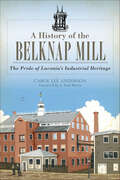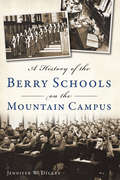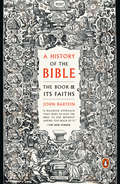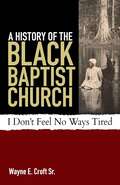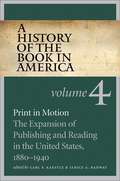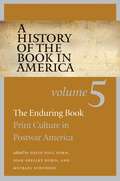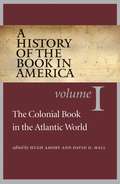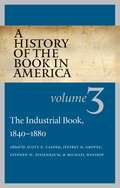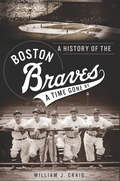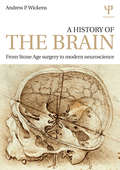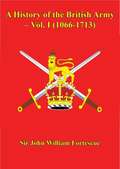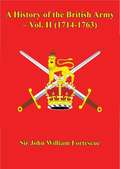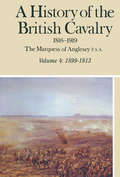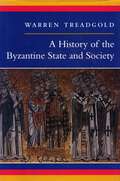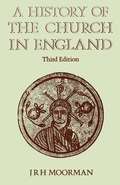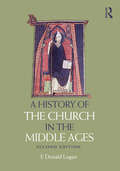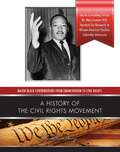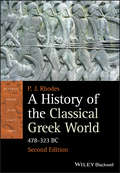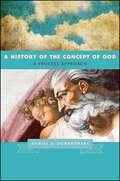- Table View
- List View
A History of the Belknap Mill: The Pride of Laconia's Industrial Heritage (Landmarks)
by Carol Lee AndersonLaconia's Belknap Mill thrived in the boom of the Industrial Revolution. The historic mill swiftly rose to the forefront of the city's hosiery industry in the nineteenth century. Lakes Region historian Carol Lee Anderson reveals the mill's unique history, including its inventive, entrepreneurial owners, their climb to industrial success and the challenges they overcame. This fascinating story encompasses the saga of countless French-Canadian immigrants whose arrival in the Lakes Region influenced the course of industry and daily life in the city of Laconia. The mill's story continues, and the preservation of this historic textile mill includes a fierce struggle of historic values versus urban renewal. Learn how this early symbol of the Industrial Revolution fought to become the pride of Laconia's industrial heritage.
A History of the Berry Schools on the Mountain Campus
by Jennifer DickeyAt the dawn of the twentieth century, Martha Berry had a vision that a residential school for young men and women with limited educational opportunities would help break the cycle of poverty that pervaded the rural South. She began an educational experiment in northwest Georgia that unfolded during her lifetime and continues into the twenty-first century. This book tells the story of a part of that school--the high school that existed on the Mountain Campus at Berry for more than six decades. For the students who were educated there, the school was transformative. As one alumnus explained, the school had about it an "intangible magic." Join author and Berry Academy alumna Jennifer Dickey as she captures the spirit of that school that today lives on in the "head, heart and hands" of its graduates.
A History of the Bible: The Story of the World's Most Influential Book
by John BartonA literary history of our most influential book of all time, by an Oxford scholar and Anglican priestIn our culture, the Bible is monolithic: It is a collection of books that has been unchanged and unchallenged since the earliest days of the Christian church. The idea of the Bible as "Holy Scripture," a non-negotiable authority straight from God, has prevailed in Western society for some time. And while it provides a firm foundation for centuries of Christian teaching, it denies the depth, variety, and richness of this fascinating text. In A History of the Bible, John Barton argues that the Bible is not a prescription to a complete, fixed religious system, but rather a product of a long and intriguing process, which has inspired Judaism and Christianity, but still does not describe the whole of either religion. Barton shows how the Bible is indeed an important source of religious insight for Jews and Christians alike, yet argues that it must be read in its historical context--from its beginnings in myth and folklore to its many interpretations throughout the centuries. It is a book full of narratives, laws, proverbs, prophecies, poems, and letters, each with their own character and origin stories. Barton explains how and by whom these disparate pieces were written, how they were canonized (and which ones weren't), and how they were assembled, disseminated, and interpreted around the world--and, importantly, to what effect. Ultimately, A History of the Bible argues that a thorough understanding of the history and context of its writing encourages religious communities to move away from the Bible's literal wording--which is impossible to determine--and focus instead on the broader meanings of scripture.
A History of the Black Baptist Church: Don't Feel No Ways Tired
by Wayne E. CroftThe history of black people in the United States is a history of challenge and resilience, of suffering and solidarity, of injustice and prophetic resistance. It is a history steeped in the hope and strength that African Americans have derived from their faith in God and from the church that provided safety, community, consolation, and empowerment. In this new volume from pastor and scholar Rev. Dr. Wayne Croft, the history of the black Baptist church unfolds" "from its theological roots in the Radical Reformation of Europe and North America, to the hush arbors and praise houses of slavery's invisible institution, to the evolution of distinctively black denominations. In a wonderfully readable narrative style, the author relates the development of diverse black Baptist associations and conventions, from the eighteenth century through the twentieth century's civil rights movement. Ideal for clergy and laity alike, the book highlights key leaders, theological concepts, historic events, and social concerns that influenced the growth of what we know today as the diverse black Baptist family of churches.
A History of the Book in America
by Janice A. Radway Carl F. KaestleIn a period characterized by expanding markets, national consolidation, and social upheaval, print culture picked up momentum as the nineteenth century turned into the twentieth. Books, magazines, and newspapers were produced more quickly and more cheaply, reaching ever-increasing numbers of readers. Volume 4 of A History of the Book in America traces the complex, even contradictory consequences of these changes in the production, circulation, and use of print. Contributors to this volume explain that although mass production encouraged consolidation and standardization, readers increasingly adapted print to serve their own purposes, allowing for increased diversity in the midst of concentration and integration. Considering the book in larger social and cultural networks, essays address the rise of consumer culture, the extension of literacy and reading through schooling, the expansion of secondary and postsecondary education and the growth of the textbook industry, the growing influence of the professions and their dependence on print culture, and the history of relevant technology. As the essays here attest, the expansion of print culture between 1880 and 1940 enabled it to become part of Americans' everyday business, social, political, and religious lives. Contributors:Megan Benton, Pacific Lutheran UniversityPaul S. Boyer, University of Wisconsin-MadisonUna M. Cadegan, University of DaytonPhyllis Dain, Columbia UniversityJames P. Danky, University of Wisconsin-MadisonEllen Gruber Garvey, New Jersey City UniversityPeter Jaszi, American UniversityCarl F. Kaestle, Brown UniversityNicolas Kanellos, University of HoustonRichard L. Kaplan, ABC-Clio PublishingMarcel Chotkowski LaFollette, Washington, D.C.Elizabeth Long, Rice UniversityElizabeth McHenry, New York UniversitySally M. Miller, University of the PacificRichard Ohmann, Wesleyan UniversityJanice A. Radway, Duke UniversityJoan Shelley Rubin, University of RochesterJonathan D. Sarna, Brandeis UniversityCharles A. Seavey, University of Missouri, ColumbiaMichael Schudson, University of California, San DiegoWilliam Vance Trollinger Jr., University of DaytonRichard L. Venezky (1938-2004)James L. W. West III, Pennsylvania State UniversityWayne A. Wiegand, Florida State UniversityMichael Winship, University of Texas at AustinMartha Woodmansee, Case Western Reserve UniversityThe contributors are Megan Benton, Paul S. Boyer, Una M. Cadegan, Phyllis Dain, James P. Danky, Ellen Gruber Garvey, Peter Jaszi, Carl F. Kaestle, Nicolas Kanellos, Richard L. Kaplan, Marcel Chotkowski LaFollette, Elizabeth Long, Elizabeth McHenry, Sally M. Miller, Richard Ohmann, Janice A. Radway, Joan Shelley Rubin, Jonathan D. Sarna, Charles A. Seavey, Michael Schudson, William Vance Trollinger Jr., Richard L. Venezky, James L. W. West III, Wayne A. Wiegand, Michael Winship, and Martha Woodmansee.-->
A History of the Book in America
by Michael Schudson Joan Shelley Rubin David Paul NordThe fifth volume of A History of the Book in America addresses the economic, social, and cultural shifts affecting print culture from World War II to the present. During this period factors such as the expansion of government, the growth of higher education, the climate of the Cold War, globalization, and the development of multimedia and digital technologies influenced the patterns of consolidation and diversification established earlier.The thirty-three contributors to the volume explore the evolution of the publishing industry and the business of bookselling. The histories of government publishing, law and policy, the periodical press, literary criticism, and reading--in settings such as schools, libraries, book clubs, self-help programs, and collectors' societies--receive imaginative scrutiny as well. The Enduring Book demonstrates that the corporate consolidations of the last half-century have left space for the independent publisher, that multiplicity continues to define American print culture, and that even in the digital age, the book endures.Contributors:David Abrahamson, Northwestern UniversityJames L. Baughman, University of Wisconsin-MadisonKenneth Cmiel (d. 2006)James Danky, University of Wisconsin-MadisonRobert DeMaria Jr., Vassar CollegeDonald A. Downs, University of Wisconsin-MadisonRobert W. Frase (d. 2003)Paul C. Gutjahr, Indiana UniversityDavid D. Hall, Harvard Divinity SchoolJohn B. Hench, American Antiquarian SocietyPatrick Henry, New York City College of TechnologyDan Lacy (d. 2001)Marshall Leaffer, Indiana UniversityBruce Lewenstein, Cornell UniversityElizabeth Long, Rice UniversityBeth Luey, Arizona State UniversityTom McCarthy, Beirut, LebanonLaura J. Miller, Brandeis UniversityPriscilla Coit Murphy, Chapel Hill, N.C.David Paul Nord, Indiana UniversityCarol Polsgrove, Indiana UniversityDavid Reinking, Clemson UniversityJane Rhodes, Macalester CollegeJohn V. Richardson Jr., University of California, Los AngelesJoan Shelley Rubin, University of RochesterMichael Schudson, University of California, San Diego, and Columbia UniversityLinda Scott, University of OxfordDan Simon, Seven Stories PressIlan Stavans, Amherst CollegeHarvey M. Teres, Syracuse UniversityJohn B. Thompson, University of CambridgeTrysh Travis, University of FloridaJonathan Zimmerman, New York University
A History of the Book in America
by Robert A. Gross Mary KelleyVolume Two of A History of the Book in America documents the development of a distinctive culture of print in the new American republic.Between 1790 and 1840 printing and publishing expanded, and literate publics provided a ready market for novels, almanacs, newspapers, tracts, and periodicals. Government, business, and reform drove the dissemination of print. Through laws and subsidies, state and federal authorities promoted an informed citizenry. Entrepreneurs responded to rising demand by investing in new technologies and altering the conduct of publishing. Voluntary societies launched libraries, lyceums, and schools, and relied on print to spread religion, redeem morals, and advance benevolent goals. Out of all this ferment emerged new and diverse communities of citizens linked together in a decentralized print culture where citizenship meant literacy and print meant power. Yet in a diverse and far-flung nation, regional differences persisted, and older forms of oral and handwritten communication offered alternatives to print. The early republic was a world of mixed media.Contributors: Elizabeth Barnes, College of William and MaryGeorgia B. Barnhill, American Antiquarian SocietyJohn L. Brooke, The Ohio State UniversityDona Brown, University of VermontRichard D. Brown, University of ConnecticutKenneth E. Carpenter, Harvard University LibrariesScott E. Casper, University of Nevada, RenoMary Kupiec Cayton, Miami UniversityJoanne Dobson, Brewster, New YorkJames N. Green, Library Company of PhiladelphiaDean Grodzins, Massachusetts Historical SocietyRobert A. Gross, University of ConnecticutGrey Gundaker, College of William and MaryLeon Jackson, University of South CarolinaRichard R. John, Columbia UniversityMary Kelley, University of MichiganJack Larkin, Clark UniversityDavid Leverenz, University of FloridaMeredith L. McGill, Rutgers UniversityCharles Monaghan, Charlottesville, VirginiaE. Jennifer Monaghan, Brooklyn College of The City University of New YorkGerald F. Moran, University of Michigan-DearbornKaren Nipps, Harvard UniversityDavid Paul Nord, Indiana UniversityBarry O'Connell, Amherst CollegeJeffrey L. Pasley, University of Missouri-ColumbiaWilliam S. Pretzer, Central Michigan UniversityA. Gregg Roeber, Pennsylvania State UniversityDavid S. Shields, University of South CarolinaAndie Tucher, Columbia UniversityMaris A. Vinovskis, University of MichiganSandra A. Zagarell, Oberlin College
A History of the Book in America, 5-volume Omnibus E-book
by David D. HallThe five volumes in A History of the Book in America offer a sweeping chronicle of our country's print production and culture from colonial times to the end of the twentieth century. This interdisciplinary, collaborative work of scholarship examines the book trades as they have developed and spread throughout the United States; provides a history of U.S. literary cultures; investigates the practice of reading and, more broadly, the uses of literacy; and links literary culture with larger themes in American history.Now available for the first time, this complete Omnibus ebook contains all 5 volumes of this landmark work.Volume 1The Colonial Book in the Atlantic WorldEdited by Hugh Amory and David D. Hall664 pp., 51 illus.Volume 2An Extensive Republic: Print, Culture, and Society in the New Nation, 1790-1840Edited by Robert A. Gross and Mary Kelley712 pp., 66 illus.Volume 3The Industrial Book, 1840-1880Edited by Scott E. Casper, Jeffrey D. Groves, Stephen W. Nissenbaum, and Michael Winship560 pp., 43 illus.Volume 4Print in Motion: The Expansion of Publishing and Reading in the United States, 1880-1940Edited by Carl F. Kaestle and Janice A. Radway688 pp., 74 illus.Volume 5The Enduring Book: Print Culture in Postwar AmericaEdited by David Paul Nord, Joan Shelley Rubin, and Michael Schudson632 pp., 95 illus.
A History of the Book in America- Volume 3
by David D. Hall Hugh AmoryThe Colonial Book in the Atlantic World carries the interrelated stories of publishing, writing, and reading from the beginning of the colonial period in America up to 1790. Three major themes run through the volume: the persisting connections between the book trade in the Old World and the New, evidenced in modes of intellectual and cultural exchange and the dominance of imported, chiefly English books; the gradual emergence of a competitive book trade in which newspapers were the largest form of production; and the institution of a "culture of the Word," organized around an essentially theological understanding of print, authorship, and reading, complemented by other frameworks of meaning that included the culture of republicanism. The Colonial Book in the Atlantic World also traces the histories of literary and learned culture, censorship and "freedom of the press," and literacy and orality.Contributors:Hugh AmoryRoss W. Beales, The College of the Holy CrossJohn Bidwell, Princeton University LibraryRichard D. Brown, University of ConnecticutCharles E. Clark, University of New HampshireJames N. Green, Library Company of PhiladelphiaDavid D. Hall, Harvard Divinity SchoolRussell L. Martin, Southern Methodist UniversityE. Jennifer Monaghan, Brooklyn College of The City University of New YorkJames Raven, University of EssexElizabeth Carroll Reilly, Hardwick, MassachusettsA. Gregg Roeber, Pennsylvania State UniversityDavid S. Shields, University of South CarolinaCalhoun Winton, University of Maryland
A History of the Book in America- Volume 5
by Michael Winship Stephen W. Nissenbaum Jeffrey D. Groves Scott E. CasperVolume 3 of A History of the Book in America narrates the emergence of a national book trade in the nineteenth century, as changes in manufacturing, distribution, and publishing conditioned, and were conditioned by, the evolving practices of authors and readers. Chapters trace the ascent of the "industrial book--a manufactured product arising from the gradual adoption of new printing, binding, and illustration technologies and encompassing the profusion of nineteenth-century printed materials--which relied on nationwide networks of financing, transportation, and communication. In tandem with increasing educational opportunities and rising literacy rates, the industrial book encouraged new sites of reading; gave voice to diverse communities of interest through periodicals, broadsides, pamphlets, and other printed forms; and played a vital role in the development of American culture.Contributors:Susan Belasco, University of NebraskaCandy Gunther Brown, Indiana UniversityKenneth E. Carpenter, Newton Center, MassachusettsScott E. Casper, University of Nevada, RenoJeannine Marie DeLombard, University of TorontoAnn Fabian, Rutgers UniversityJeffrey D. Groves, Harvey Mudd CollegePaul C. Gutjahr, Indiana UniversityDavid D. Hall, Harvard Divinity SchoolDavid M. Henkin, University of California, BerkeleyBruce Laurie, University of Massachusetts, AmherstEric Lupfer, Humanities TexasMeredith L. McGill, Rutgers UniversityJohn Nerone, University of IllinoisStephen W. Nissenbaum, University of MassachusettsLloyd Pratt, Michigan State UniversityBarbara Sicherman, Trinity CollegeLouise Stevenson, Franklin & Marshall CollegeAmy M. Thomas, Montana State UniversityTamara Plakins Thornton, State University of New York, BuffaloSusan S. Williams, Ohio State UniversityMichael Winship, University of Texas at Austin
A History of the Boston Braves: A Time Gone By (Sports Ser.)
by William J. CraigThe story of the beloved baseball team that kept the city cheering through the Great Depression and two world wars—includes photos. For those lucky enough to have passed through the turnstiles of Braves Field, the Boston Braves will forever live in the corridors of their collective memory. Baseball legend Babe Ruth finished his career on the historic diamond at Braves Field, while Hall of Famer Eddie Mathews was just getting started. When the franchise moved the team to Milwaukee in 1953, the Boston Braves helped usher in the modern age of Major League Baseball. Travel back to the Wig-Wam with author William J. Craig, to a time when players arrived at the ballpark by trolley car and a seat in the bleachers cost sixty cents. From the astounding 1948 pennant season to the final inning, Craig pays tribute to a team that Boston fans will never forget.
A History of the Boston and Maine Railroad: Exploring New Hampshire's Rugged Heart by Rail (Brief History)
by Bruce D. HealdOn June 27, 1835, New Hampshire chartered the Boston & Maine Railroad, and a juggernaut was born. By 1900, the B&M operated some 2,300 miles of track in northern New England, having taken over an astonishing forty-seven different railroads since its inception. The B&M loomed particularly large in the Granite State, where it controlled 96 percent of all tracks and was the primary conveyance through the rugged heart of New England s most formidable mountain range.From the gravity-defying Mount Washington Cog Railway to logging transport trains to the famous Depression-era Snow Train, A History of the Boston & Maine Railroad traces the fascinating history of New England's most renowned railway.
A History of the Brain: From Stone Age surgery to modern neuroscience
by Andrew P. WickensA History of the Brain tells the full story of neuroscience, from antiquity to the present day. It describes how we have come to understand the biological nature of the brain, beginning in prehistoric times, and progressing to the twentieth century with the development of Modern Neuroscience. This is the first time a history of the brain has been written in a narrative way, emphasizing how our understanding of the brain and nervous system has developed over time, with the development of the disciplines of anatomy, pharmacology, physiology, psychology and neurosurgery. The book covers: beliefs about the brain in ancient Egypt, Greece and Rome the Medieval period, Renaissance and Enlightenment the nineteenth century the most important advances in the twentieth century and future directions in neuroscience. The discoveries leading to the development of modern neuroscience gave rise to one of the most exciting and fascinating stories in the whole of science. Written for readers with no prior knowledge of the brain or history, the book will delight students, and will also be of great interest to researchers and lecturers with an interest in understanding how we have arrived at our present knowledge of the brain.
A History of the British Army – Vol. I (A History of the British Army #1)
by Sir John William FortescueSir John Fortescue holds a pre-eminent place amongst British military historians, his enduring fame and legacy resting mainly on his life's work "The History of the British Army", issued in 20 volumes, which took him some 30 years to complete. In scope and breadth it is such that no modern scholar has attempted to cover such a large and diverse subject in its entirety; but Sir John did so with aplomb, leading to a readable and comprehensive study.According to Professor Emeritus of Military History at King's College, Brian Bond, the work was "the product of indefatigable research in original documents, a determination to present a clear, accurate, and readable narrative of military operations, and a close personal knowledge of the battlefields, which enabled him to elucidate his account with excellent maps. Most important, however, was his motivation: namely, a lifelong affection for the old, long-service, pre-Cardwell army, the spirit of the regiments of which it largely consisted, and the value of its traditions to the nation. An important part of his task was to distil and inculcate these soldierly virtues which, in his conservative view, contrasted sharply with the unedifying character of politicians who habitually meddled in military matters." ODNB.This first volume covers the period from the battle of Hastings in 1066 to the end of the Seven Year's War in 1713. It includes the battles at Bannockburn, Crecy, Agincourt, Flodden, the battles of the English Civil War, Dunkirk Dunes, Tangiers, and the battles during Marlborough's campaigns. The volume also traces the development of European Armies, infantry, cavalry and artillery, and the specific changes in Britain during the period.A MUST READ for any military enthusiast.Author -- Fortescue, J. W. Sir, 1859-1933.Text taken, whole and complete, from the second edition published in 1910, London, by Macmillan and Co.Original Page Count - XXXV and 593 pages.Illustrations -- Numerous.
A History of the British Army – Vol. II (A History of the British Army #2)
by Sir John William FortescueSir John Fortescue holds a pre-eminent place amongst British military historians, his enduring fame and legacy resting mainly on his life's work "The History of the British Army", issued in 20 volumes, which took him some 30 years to complete. In scope and breadth it is such that no modern scholar has attempted to cover such a large and diverse subject in its entirety; but Sir John did so and with aplomb, leading to a readable and comprehensive study.According to Professor Emeritus of Military History at King's College, Brian Bond, the work was "the product of indefatigable research in original documents, a determination to present a clear, accurate, and readable narrative of military operations, and a close personal knowledge of the battlefields, which enabled him to elucidate his account with excellent maps. Most important, however, was his motivation: namely, a lifelong affection for the old, long-service, pre-Cardwell army, the spirit of the regiments of which it largely consisted, and the value of its traditions to the nation. An important part of his task was to distil and inculcate these soldierly virtues which, in his conservative view, contrasted sharply with the unedifying character of politicians who habitually meddled in military matters." ODNB.This second volume covers the period from 1713 to 1763, including the Jacobite rebellion of 1715, the wars of Austrian Succession, and British expansion into America and India and the enduring struggle with France for Imperial power.A MUST READ for any military enthusiast.Author -- Fortescue, J. W. Sir, 1859-1933.Text taken, whole and complete, from the second edition published in 1910, London, by Macmillan and Co.Original Page Count - xxii and 606 pages.Illustrations -- Numerous maps and plans
A History of the British Cavalry, 1816–1850 Volume 1: 1816–1919
by The Marquess of AngleseyIn-depth coverage of the Charge of the Light Brigade, and the numerous colonial campaigns of the period.
A History of the British Cavalry, 1899–1913 Volume 4: 1816–1919
by The Marquess of AngleseyIn the seventh, and second last, volume in t his historical work, Lord Anglesey shows how superior the Br itish cavalry was compared to those of the French and German s. He concentrates on the first five months of the War. '
A History of the British Isles
by Jeremy BlackFrom the preface: "The history of the British Isles is the history of the English, Irish, Scots and Welsh..." And from the introduction "The selection of central themes (in this book) is therefore in large part a personal response to the multifaceted nature of the past. Two emerge clearly: first the political relations both between the constituent parts of Britain and between them and the rest of Europe; and secondly the impact of technology..."
A History of the Byzantine State and Society
by Warren TreadgoldThis is the first comprehensive and up-to-date history of Byzantium to appear in almost sixty years, and the first ever to cover both the Byzantine state and Byzantine society. It begins in A.D. 285, when the emperor Diocletian separated what became Byzantium from the western Roman Empire, and ends in 1461, when the last Byzantine outposts fell to the Ottoman Turks. Spanning twelve centuries and three continents, the Byzantine Empire linked the ancient and modern worlds, shaping and transmitting Greek, Roman, and Christian traditions--including the Greek classics, Roman law, and Christian theology--that remain vigorous today, not only in Eastern Europe and the Middle East but throughout Western civilization. Though in its politics Byzantium often resembled a third-world dictatorship, it has never yet been matched in maintaining a single state for so long, over a wide area inhabited by heterogeneous peoples. Drawing on a wealth of original sources and modern works, the author treats political and social developments as a single vivid story, told partly in detailed narrative and partly in essays that clarify long-term changes. He avoids stereotypes and rejects such old and new historical orthodoxies as the persistent weakness of the Byzantine economy and the pervasive importance of holy men in Late Antiquity. Without neglecting underlying social, cultural, and economic trends, the author shows the often crucial impact of nearly a hundred Byzantine emperors and empresses. What the emperor or empress did, or did not do, could rapidly confront ordinary Byzantines with economic ruin, new religious doctrines, or conquest by a foreign power. Much attention is paid to the complex life of the court and bureaucracy that has given us the adjective "byzantine." The major personalities include such famous names as Constantine, Justinian, Theodora, and Heraclius, along with lesser-known figures like Constans II, Irene, Basil II the Bulgar-Slayer, and Michael VIII Palaeologus. Byzantine civilization emerges as durable, creative, and realistic, overcoming repeated setbacks to remain prosperous almost to the end. With 221 illustrations and 18 maps that complement the text, A History of the Byzantine State and Society should long remain the standard history of Byzantium not just for students and scholars but for all readers.
A History of the Carpenters Company (Routledge Revivals)
by B W Alford T BARKERFirst published in 1968, A History of the Carpenters Company deals with developments in the carpenter’s craft as well as with the Company's own internal growth. It examines the effectiveness of efforts to enforce regulations dealing with wages, apprenticeship, and building, which emanated from both the Company and the Common Council of the City of London. The Great Fire of 1666 had profound effects on the organization which struggled on with a meager income until railway compensation and the enhancement of property values, in the second-half of the nineteenth century, transformed it into one of the wealthiest of the City Livery Companies. The Carpenters’ unusually complete records have not only enabled the authors to trace the acquisition of property, but also to illustrate the legal fictions used to protect this property from unscrupulous demands of Tudor and Stuart monarchs, and, at the same time, to question some of the existing general accounts of the apparent rise in charitable activity during that period. The domestic life of the Company, its charities, and successive halls, are all described.Throughout, an attempt has been made to trace the social and economic life of the Carpenters against a backcloth of London and National History. This book is an important historical reference work for students of British history.
A History of the Church in England (3rd Edition)
by J R MoormanA lively account of Christianity in Britain, from the Roman and Celtic eras up through the Reformation and the modern church. This authoritative account of the Church in England covers its history from earliest times to the late twentieth century—including chapters on the Roman, Celtic, Anglo-Saxon, Norman, and Medieval periods before a description of the Reformation and its effects, the Stuart period, and the Industrial Age, with a final chapter on the modern church through 1972. After shedding light on how the faith spread during ancient times with historical tales of conversion and persecution, and revealing the details behind figures like St. Patrick, his interactions with pagan Irish tribes, and the monasteries he founded, the book goes on to cover the conversion of England, including the legendary stories of St. Gregory the Great and the Anglian boys and Augustine’s baptism of over ten thousand people in the area of Canterbury on a single Christmas Day. Moving on through the centuries, it tells of scholars like Aldhelm, Bede, and Alcuin; Viking invasions; kings, popes, and power struggles; and the translation of the Bible. It conveys the impact of world-changing individuals like Henry VIII and Martin Luther and the breach with Rome; then moving toward the modern period tells of the evolution of the Church of England, the early Evangelicals, and the social and cultural changes of the twentieth century. With fascinating detail on the church’s role in everything from art and architecture to education, this is a wide-ranging look at British history through the perspective of religion.
A History of the Church in the Middle Ages
by F Donald Logan"Conceptually well organized, stylistically clear, intellectually thoughtful, and pedagogically useful." - Thomas Head, Speculum "For its humane and learned approach to its enormous canvas, as well as for the cogency with which it penetrates at speed to the essentials of a vanished historical epoch, this History of the Church in the Middle Ages deserves a very wide audience indeed." - Barrie Dobson, English Historical Review "To have written a scholarly and very readable history of the Western Church over a millennium is a remarkable tour de force, for which Donald Logan is to be warmly congratulated." - C.H Lawrence, The Tablet "A feat of historical synthesis, most confident in its telling of the coming of Christianity. Books like Logan's are needed more than ever before." - Miri Rubin, TLS In this fascinating survey, F. Donald Logan introduces the reader to the Christian church, from the conversion of the Celtic and Germanic peoples to the discovery of the New World. He reveals how the church unified the people of Western Europe as they worshipped with the same ceremonies and used Latin as the language of civilized communication. From remote, rural parish to magnificent urban cathedral, A History of the Church in the Middle Ages explores the role of the church as a central element in determining a thousand years of history. This new edition brings the book right up to date with recent scholarship, and includes an expanded introduction exploring the interaction of other faiths - particularly Judaism and Islam - with the Christian church.
A History of the Civil Rights Movement (Major Black Contributions from Emancipat)
by M. Lavora Perry"The arc of the moral universe is long," Martin Luther King Jr. once observed, "but it bends toward justice." In this book, you'll read about many courageous people--including Dr. King himself--who worked for justice during the long struggle for African-American civil rights.
A History of the Classical Greek World: 478 - 323 BC (Blackwell History of the Ancient World #11)
by P. J. RhodesThoroughly updated and revised, the second edition of this successful and widely praised textbook offers an account of the ‘classical’ period of Greek history, from the aftermath of the Persian Wars in 478 BC to the death of Alexander the Great in 323 BC. Two important new chapters have been added, covering life and culture in the classical Greek world Features new pedagogical tools, including textboxes, and a comprehensive chronological table of the West, mainland Greece, and the Aegean Enlarged and additional maps and illustrative material Covers the history of an important period, including: the flourishing of democracy in Athens; the Peloponnesian war, and the conquests of Alexander the Great Focuses on the evidence for the period, and how the evidence is to be interpreted
A History of the Concept of God: A Process Approach
by Daniel A. DombrowskiDaniel A. Dombrowski explores the history of the concept of God from the perspective of neoclassical, or process, theism. His neoclassical approach assuages the current crisis in philosophical theism, caught between a defense of classical theism and assertions of religious skepticism. Instead, the work offers Charles Hartshorne's notion of a God who always evolves, quite unlike the allegedly perfect figure of more traditional, and increasingly unsatisfactory, accounts. Dombrowski surveys the classical theists and their roots in ancient Greek philosophy before turning to contributions from the sixteenth through twentieth centuries, ultimately discussing twenty-three thinkers. The key figures in this history are Plato, who ironically provided the philosophical basis both for classical and neoclassical concepts, and three great figures in process theism: Henri Bergson, Alfred North Whitehead, and Hartshorne. The concept of God has a rich past; this book argues that it can have a rich future as well.
